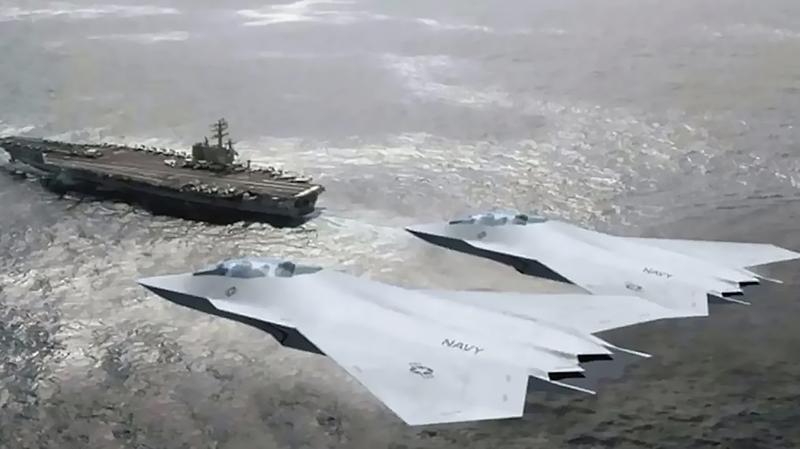This article is published in Aviation Week & Space Technology and is free to read until Jul 25, 2025. If you want to read more articles from this publication, please click the link to subscribe.

The Navy’s next fighter is still needed, but U.S. defense officials are skeptical that the defense industry is ready.
The world will soon learn whether China’s defense industry can usher two different sixth-generation fighters through testing, develop a stealth bomber and ramp up production of several fourth- and fifth-generation fighter types—all at the same time. Meanwhile, Pentagon leaders are questioning whether the U.S. defense industry is capable of pulling off a similar feat.
With three variants of the Lockheed Martin F-35, the Boeing F-15EX and the Northrop Grumman B-21 in various stages of development, production and modernization, the Air Force launched development of the F-47 on March 21. The Navy was expected to follow suit shortly afterward in selecting either Boeing or Northrop to launch the engineering and manufacturing development (EMD) phase of the F/A-XX fighter.
- F/A-XX contract award is put on hold for review
- U.S. military leaders reaffirm that the requirement is valid
But the F/A-XX is now on hold while the Navy determines whether the U.S. defense industry has the capacity to deliver the program on time and on budget while keeping up with other commitments.
Gen. Daniel Caine, chairman of the Joint Chiefs of Staff, told the House Armed Services Committee on June 12 that the approved requirement for a carrier-based sixth-generation fighter remains valid, but there are concerns about the “timing and synchronization” of the F/A-XX program.
“I think it comes down to a question that many of the folks on the committee have talked about, and that’s the ability to produce at a particular time,” Caine said.
In some ways, the F/A-XX is a victim of systemwide failures by other U.S. defense contractors on other major acquisition programs, especially in the Navy’s troubled shipbuilding portfolio.
“All of our programs are a mess, to be honest,” Navy Secretary John Phelan told the same committee on June 11. “Our best-performing [program] is six months late and 57% over budget.”
So the Navy is reviewing whether the program should be delayed again to put space between the start of the F-47’s EMD phase and F/A-XX, while industry continues working on fielding the B-21 and producing F-35s and F-15EXs for the U.S. military.
Despite the review, Caine and the Navy’s top military leader agree that the air wing of the future still requires the F/A-XX. The Navy launched the program in 2012, seeking to replace the Boeing F/A-18E/F Super Hornet and EA-18G Growler with a new, multirole, optionally crewed fighter, starting in the 2030s.
“I believe the sixth-generation fighter is necessary for the Navy, just as it is for the Air Force,” Chief of Naval Operations Adm. James Kilby said at the June 11 hearing. “The thing that drives that necessity is the threat. . . . It’s important to continue onward here because, I think, China is not slowing down, and we shouldn’t slow down either.”
Since Dec. 26, Chinese photographers have captured two new aircraft types in flight testing. These are generally referred to as the AVIC Chengdu J-36 and AVIC Shenyang J-50, with the latter often speculated to be a candidate for fielding as a carrier-based fighter. The Chinese military confirmed in 2016 that they have been working on fielding a long-range, stealthy bomber, which U.S. military assessments expect to enter service by the end of the decade.
Meanwhile, Beijing continues to produce two fifth-generation fighters and a host of fourth-generation fighters, while modernizing the Xian H-6K bomber and experimenting with several candidates to become stealthy uncrewed combat air vehicles.
On the other side of the Pacific, the U.S. portfolio of next-generation fighters have struggled through a series of schedule delays. In the fiscal 2020 budget, the Air Force deferred the start of the EMD phase for what became the F-47 program by two years; then-Secretary Frank Kendall postponed it another 10 months to review the original requirements. Congressional documents show that the Navy also decided in 2021 or 2022 to postpone the start of the EMD phase for the F/A-XX. Those deferrals put both programs on a course to reach a downselect decision within weeks of each other this year.
Today, the Pentagon’s leadership is not sure if the U.S. defense industry can handle both jobs.
“[We’re] trying to make sure we’re not back here in two years saying, ‘We told you it was going to cost X, but it’s actually going to be X plus 50, and, by the way, it’s going to be late,’” Phelan said. “So that’s really what we’re trying to do.”






Comments